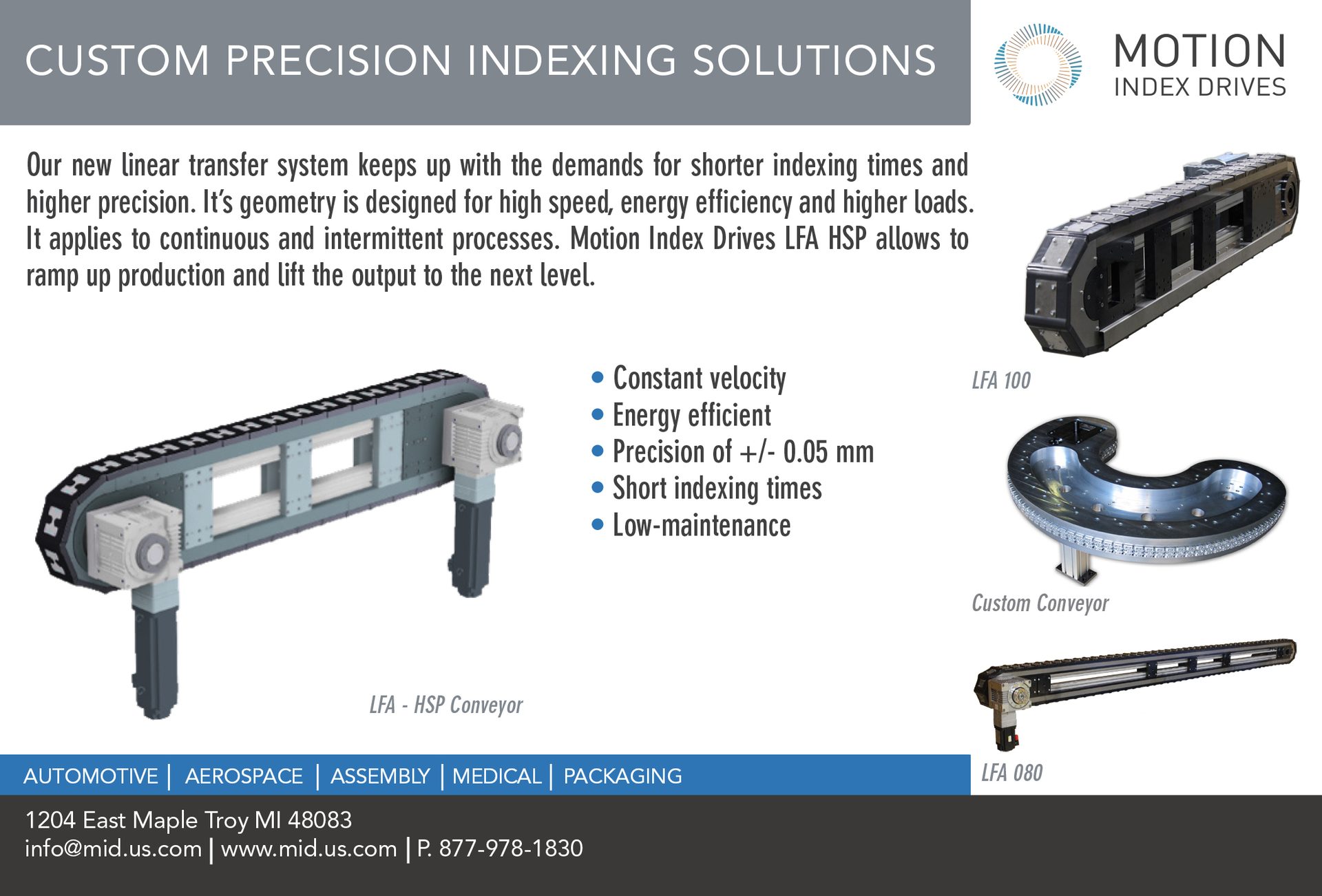CONTACT
Austin

E-airplanes are slowly taxiing toward a sustainable future.
The Electric Sky
Nathan Eddy // Contributing Writer
This regional hybrid-electric flight demonstrator will use an electric motor as part of an integrated propulsion system. Illustration courtesy Raytheon Technologies Corp.
E-airplanes are slowly taxiing toward a sustainable future.
Nathan Eddy
Contributing Writer
The Electric Sky
The electric aircraft market is still in its infancy, but that hasn't stopped an ambitious group of innovators from developing a leaner, greener future of flight. Traditional manufacturers, along with a plethora of start-ups, are leading the way.
Electric propulsion has the potential to revolutionize flight. From cleaner, quieter air travel to completely new types of aerial vehicles, the benefits could impact communities of all sizes across the globe.
Although the airline industry is currently responsible for just 2 percent of CO2 emissions globally, aviation’s share of emissions is expected to skyrocket, especially if projections for future growth in air travel occur. Worldwide demand for commercial aviation alone will grow annually by more than 3 percent over the next 20 years as air traffic returns to pre-COVID levels.
Electric and hybrid-electric propulsion can offer a viable alternative to ensure that the industry grows sustainably while minimizing the environmental impact and lowering operating costs.
While the market for battery-powered fixed-wing aircraft is still young, it’s attracting a growing number of players, including giants like Airbus and Boeing, which plan to develop zero-emission commercial aircraft over the next two decades. They are currently exploring a variety of electric and hybrid-electric propulsion technologies.
The electric aircraft ecosystem also involves companies like Honeywell, a Tier One aerospace supplier that makes electric propulsion systems, and magniX, a start-up electric motor manufacturer.
The technology has even attracted the attention of the defense sector. Earlier this year, for instance, Lockheed Martin Corp. invested in H3X Technologies Inc., a start-up company in Colorado that’s developing aviation-grade electric propulsion systems. BAE Systems and Raytheon Technologies Corp. are also pursuing various e-viation initiatives.
Despite that activity, numerous challenges face manufacturers, ranging from battery density and aircraft weight to range and the regulatory hurdles that new designs must overcome to gain approval to take to the skies. However, engineers are confident that this evolution is a necessary, cost-effective and a feasible path to a more sustainable, less expensive future of flight.
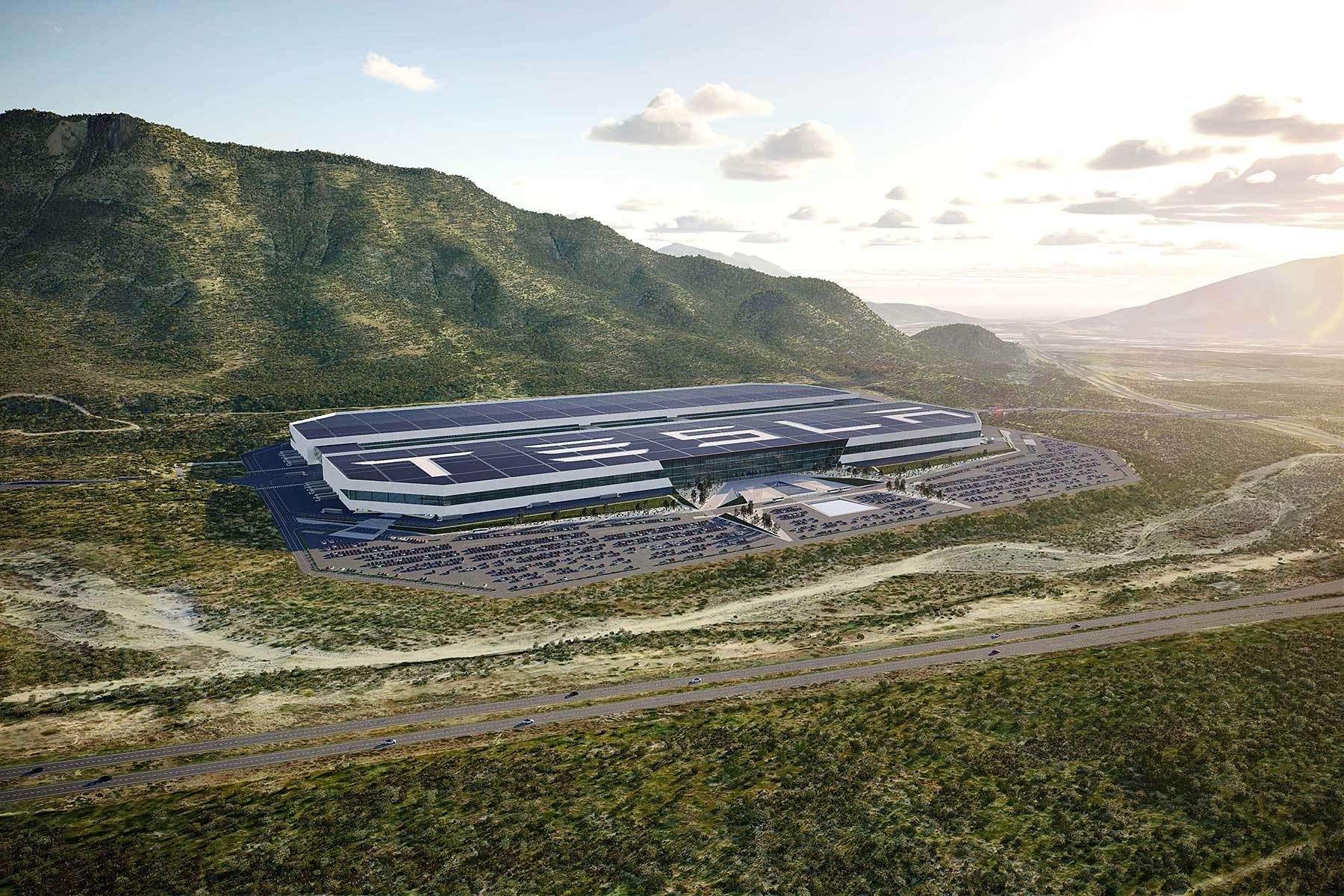
This electric aircraft can carry nine passengers or up to 2,600 pounds of cargo. Photo courtesy Eviation
First Flights
Most battery-powered aviation activity is currently focused on developing small, regional aircraft.
Raytheon recently completed a successful first engine run of the company's regional hybrid-electric flight demonstrator, marking a key milestone toward flight testing that is expected to begin next year. The propulsion system features a 1-megawatt electric motor developed by Collins Aerospace with a highly efficient Pratt & Whitney fuel-burning engine, specially adapted for hybrid-electric operation.
“This technology will enable more efficient engine performance during the different phases of flight, such as take-off, climb and cruise, reducing fuel burn and CO2 emissions by up to 30 percent compared to today's most advanced regional turboprop aircraft,” says Jean Thomassin, executive director of new products and services at Pratt & Whitney Canada.
"Hybrid-electric propulsion technology offers significant potential to optimize efficiency across a range of different aircraft applications, helping our industry meet its ambitious goal for achieving net zero CO2 emissions," claims Thomassin. "With our ground test program now well underway, planned flight testing will enable us to accelerate the demonstration of this next-generation sustainable propulsion technology.”
A De Havilland Dash 8-100 aircraft will serve as the test platform for future flight demonstrations.
Last fall, Eviation, a start-up aircraft manufacturer based near Seattle, celebrated the inaugural flight of its prototype Alice electric aircraft, which can carry nine passengers or up to 2,600 pounds of cargo. The successful test was heralded as the start of an electric future for short-haul air travel.
"The development path for getting this aircraft to market includes working with the Federal Aviation Administration (FAA) on our certification program, which is what we're doing right now,” says Gregory Davis, president and CEO of Eviation. “We're finalizing market and technical requirements.”
In 2025, the company will begin the certification flight test program, which is when the next prototype aircraft is going to be built, followed by further testing programs, before delivering the aircraft to customers in 2027. It already has orders from companies such as Air New Zealand, DHL and Global Crossing Airlines.

The BEHA features a triple-level wing architecture and two electric motors. Illustration courtesy Faradair Aerospace
xxx
xxx
- xxx
- xxx
- xxx
- xxx
xxx
AdCreative Missing.
(double-click to add)
"DHL sees Alice as a vehicle for enhancing their network through additional services," notes Davis. "The great thing about electric aircraft is that you can go and add new services without worrying about harming the environment."
The core difference between traditional turbine-powered, fuel-burning aircraft and an all-electric aircraft is the propulsion system. Rather than having fuel tanks and turbine engines, planes like Alice use batteries and electric motors.
"We're taking the advanced technology we need to get to the core issues of carbon reduction, lower costs and more convenience," explains Davis. "We're taking the path that we see gets us into the marketplace as quickly as possible."
Eviation sees that path as using conventional takeoff and landing methods and existing certification requirements.
"We're taking the current state of aircraft regulations and working with traditional aircraft designs to adapt our technology to it," says Davis. His company has produced the batteries for the Alice prototype in partnership with AVL, which makes battery systems for automakers such as Volkswagen.
According to Davis, another major benefit of electric aircraft is reduced maintenance cost, which contributes to overall operating efficiency.
"The maintenance for the turbines on a conventional aircraft is one of the key costs, while the electric motor has one moving part," Davis points out. "The overall costs of that motor are going to be substantially lower."
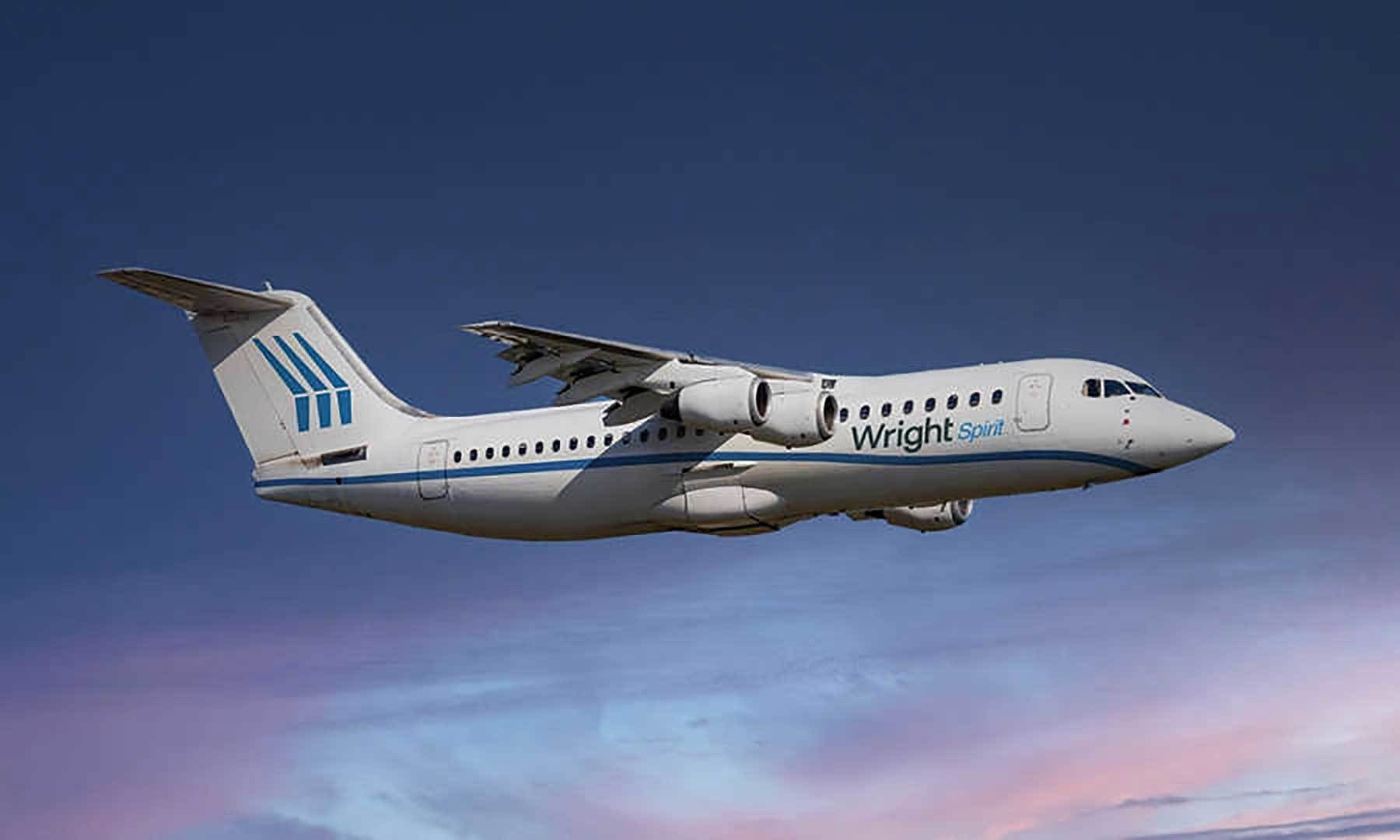
This aircraft is designed to serve the 100-passenger market for one-hour flights. Illustration courtesy Wright Electric Inc.
Appropriating the APU
British startup Faradair Aerospace Ltd. is developing a hybrid-electric passenger plane called the BEHA. It's aimed at the regional aviation market and focusing on adaptability, able to switch from a 19 seater to a cargo configuration in 15 minutes.
Faradair hopes to have the aircraft, propelled by a fan-driven electric motor, flying by 2025, with commercial use starting in 2028. The three considerations driving the company stem from the need to reduce aircraft emissions, improve cost of operations for regional flight operators and reduce noise.
"With emissions, there's an opportunity to look at how we do things differently through the evolution of electric motors, new materials and manufacturing processes, and prototyping," says Neil Cloughley, CEO of Faradair. "Timelines have shortened considerably in how you can develop new technologies and new assets."
A triple-level wing architecture allows for a short (985 feet) runway requirement for takeoff and landing, with two electric motors used for propulsion.
"The electric motor is just a phenomenal thing now," notes Cloughley. "We've had electric motors for 100 years, but now we've gotten them to such an efficient point that you have a single moving part with a huge amount of power capability in a relatively compact form footprint."
Cloughley says the big challenge facing his team of aerospace engineers was figuring out how to initially power the electric motors which would then serve as the takeoff and landing propulsion system. Faradair's answer was to repurpose the auxiliary power unit (APU) found beneath the tail of every commercial jet, which is typically used to fire up the engines.
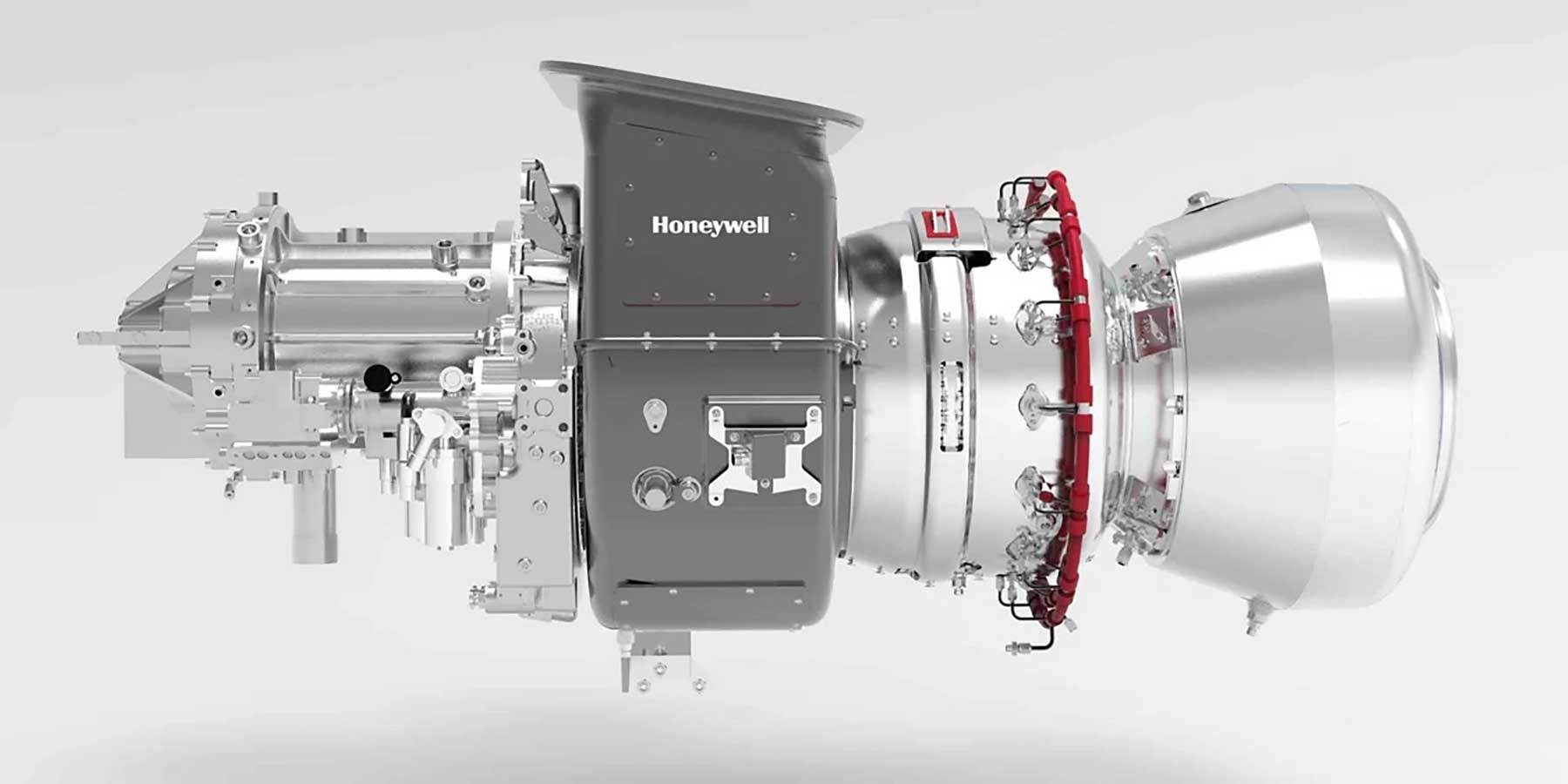
Honeywell is supplying turbogenerators to a variety of electric aircraft startups. Photo courtesy Honeywell International Inc.
"We've just taken the APU for the Airbus A350, built by Honeywell,” explains Cloughle. “Instead of using electrical power to fire up great big commercial jet engines, we use it to fire up two much smaller electric motors. It requires no infrastructure requirement from existing airfields."
The BEHA will have a battery reserve on board, but because it's not being used for the entire flight cycle, the thermal management risk is much lower.
"We can have a much smaller battery, so we don't have as much payload impact or risk, but it's enough for us to find somewhere safe to land," Cloughley points out. "If you combine that with a super high lift, short takeoff and landing capable aircraft that can land within 300 meters of any hard surface or multiple surfaces, now you've suddenly got an asset that can start going into places where you don't have huge infrastructure requirements."
Another company pioneering zero-emission flight is Wright Electric Inc. Its Wright Spirit, designed for the regional jet market, is due to begin testing later this year. The aircraft, which incorporates Wright’s megawatt-class electric propulsion system, iwill serve the 100-passenger market for one-hour flights.
“Aviation has committed to net-zero carbon emissions by 2050, but [we are] committed to a 100 percent reduction in all emissions starting in 2026,” says Jeff Engler, CEO of Wright. “Because we built the world's largest aerospace propulsive power train, we can build the world's largest zero-emissions retrofit directly serving the world's busiest routes."
The path was set in early 2020 with Wright’s announcement of its megawatt propulsion system for an all-electric commercial aircraft. Since then, the company has been proving key components of the system, including a high-efficiency, high-power density inverter and a 2-megawatt motor.
To develop the integrated propulsion system, Wright has assembled a team of companies with expertise in generation, energy storage and propulsion design. This year, the Wright Electric will begin flight testing. The company expects to have the aircraft commercially available by 2026.
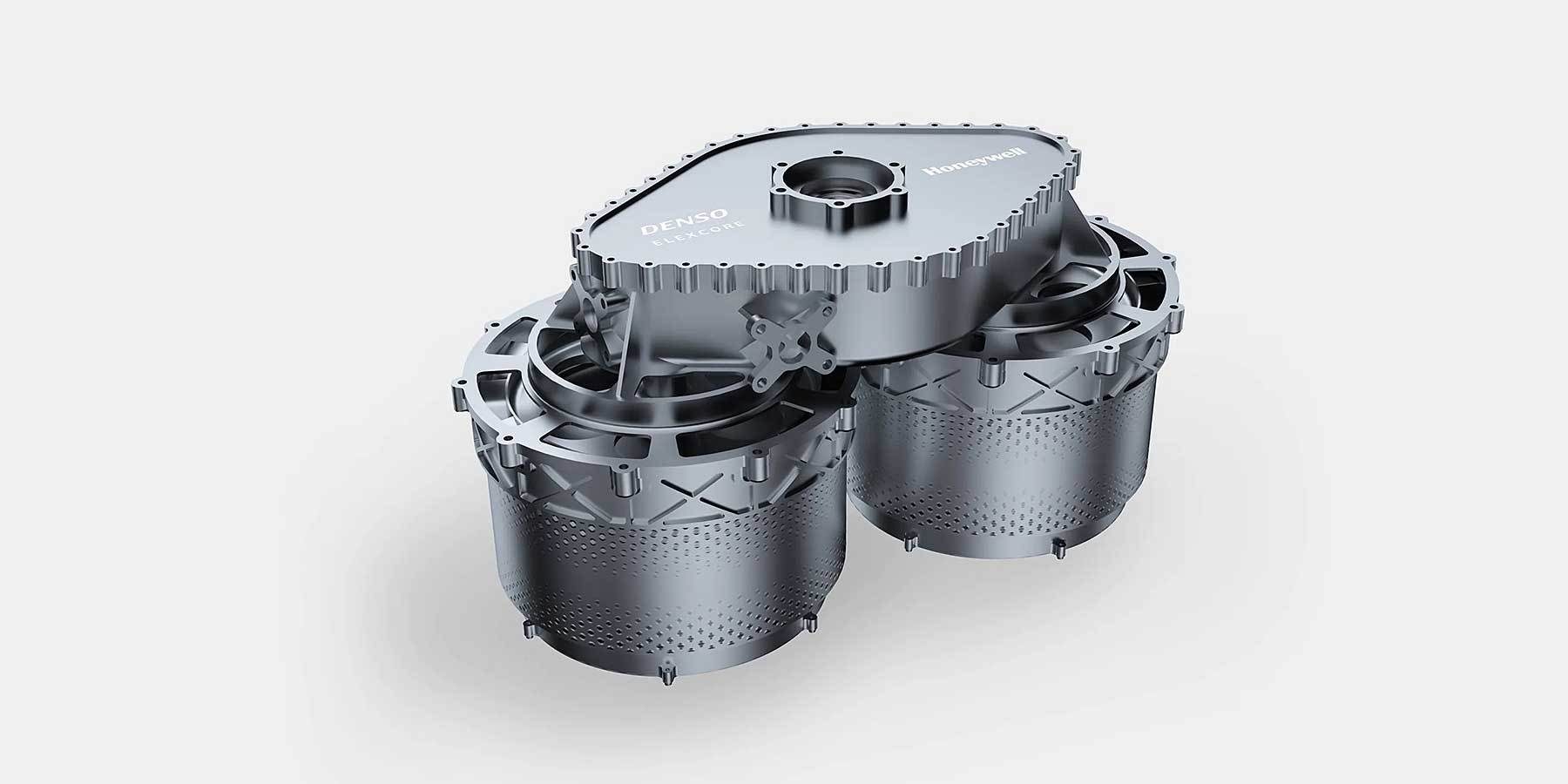
Denso and Honeywell recently formed a strategic alliance to develop electric motors and other components. Photo courtesy Honeywell International Inc.
Benefits of 'Clean Sheet' Aircraft
Honeywell Aerospace has formed a partnership with Wright, in addition to Eviation, where the company's lightweight Micro Vapor Cycle System will cool propulsion systems aboard the Alice, and Faradair, where it will provide turbogenerator units running on sustainable aviation fuel.
"[We] see a lot of clean-sheet [designs from start-up manufacturers] that are building new aircraft from the ground up," says Taylor Alberstadt, senior director of sales and marketing at Honeywell. “The requests are often for more compact, lighter weight components. That enables them to use different types of technology and deploy it in a way that meets specific needs, such as steer-by-wire systems."
According to Alberstadt, an all-electric aircraft that use one or more motors instead of a traditional gas turbine engine, typically results in a reduction of operating costs by 35 percent to 75 percent.
"Without that gas turbine engine, it's quieter, which enables you to get into different airports at different times, and it might allow unlocking additional flight plans and paths that typically you couldn't have if you have a fixed wing flying at low altitude," explains Alberstadt. "From sustainability to safety to noise abatement and reduced cost in operation, there's really a lot of reasons we want to play in this space."
Alberstadt says every gram of weight on an electric aircraft is critical. In fact, he claims that some customers are drilling holes in screws to try and take out just a little bit of excess weight.
"From a power density point of view, the lightest possible motor to achieve the desired electrical output is going to be necessary," Alberstadt points out.

The ES-30 regional electric airplane will use four battery-powered electric motors. Illustration courtesy Heart Aerospace
From Prototypes to Production Lines
In Sweden, engineers at Heart Aerospace are developing the ES-30, a regional electric airplane with a capacity of 30 passengers. In addition to using four battery-powered electric motors, it will include a reserve-hybrid configuration consisting of two turbo generators powered by sustainable aviation fuel.
The hybrid system can be used at cruising speed on longer flights to complement the electrical power provided by the batteries. It gives the airplane a fully electric range of 125 miles, plus an extended range of nearly 250 miles.
Heart has orders for more than 200 of the ES-30s, which is expected to enter service in 2028. To develop its battery, the company is working with BAE Systems.
“The battery will be the first of its kind to be integrated into an electric conventional takeoff and landing regional aircraft, allowing it to efficiently operate with zero emissions and low noise,” says Ehtisham Siddiqui, vice president and general manager of controls and avionics solutions at BAE Systems. Work on the program will be conducted at the company’s state-of-the-art facility in Endicott, NY.
“BAE Systems’ extensive experience in developing batteries for heavy-duty ground applications, and their experience in developing safety-critical control systems for aerospace, make them an ideal partner in this important next step for the ES-30,” adds Sofia Graflund, chief operating officer at Heart Aerospace.
“The ES-30 will also have a cost-effective and scalable upgrade path as future battery technology matures,” claims Graflund. “The battery upgrade roadmap allows for increased usable energy at the same weight, resulting in longer flight durations and expanded route options.”
Before the company’s assembly plant is built in Gothenburg, Heart will produce three prototypes required for the flight certification campaign, which will begin in 2025. The first aircraft will enter commercial service in 2028.
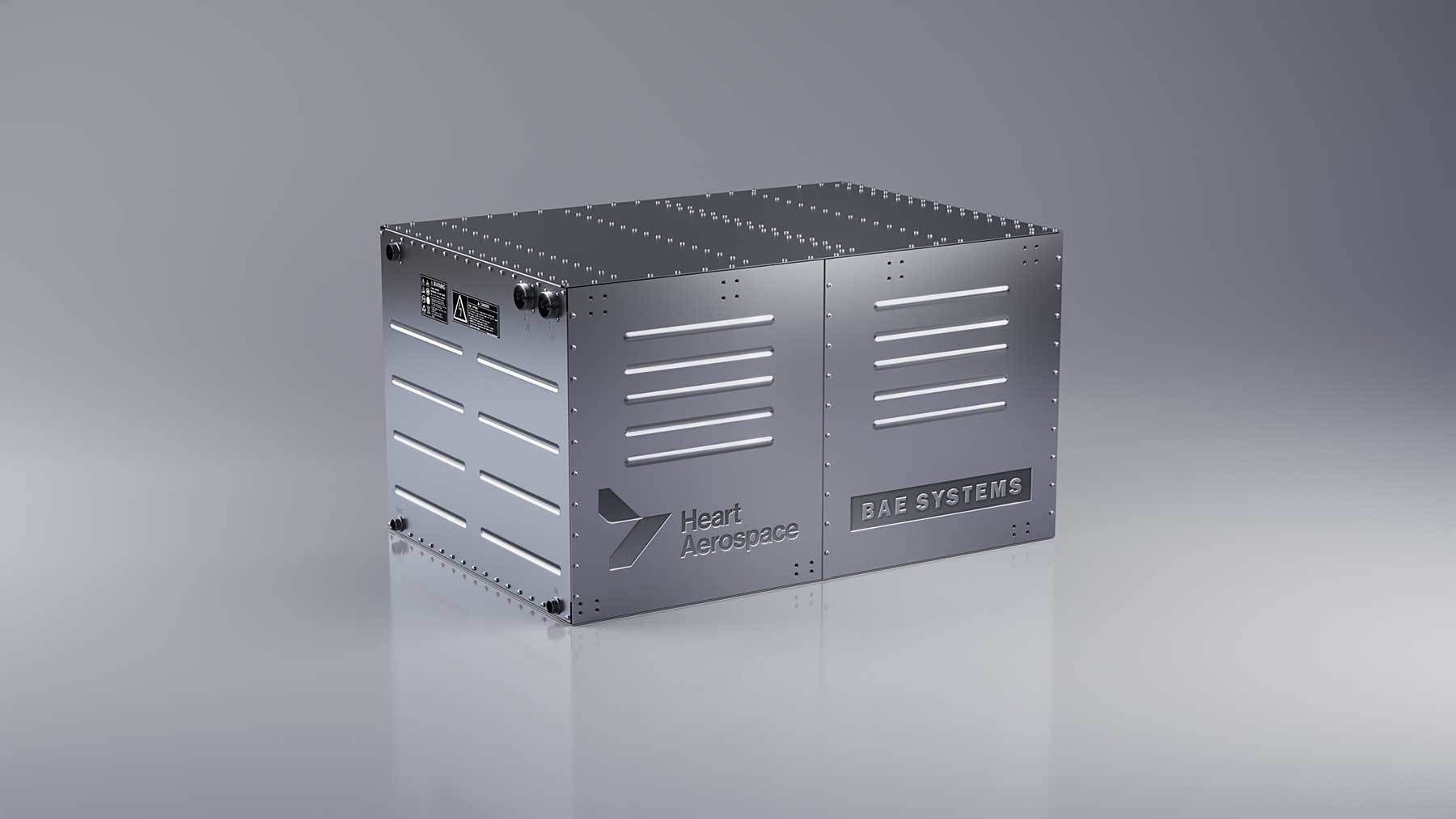
BAE Systems is working with Heart Aerospace to develop battery technology. Photo courtesy BAE Systems
"We will be ramping up to 120 aircraft per year, which means that every two days, one aircraft will roll off the assembly line," says José Fragnan, head of production at Heart. "Our new facility will be capable of producing different sizes and configurations of aircraft at the same time on the same assembly line.
"We will be able to cope with different demands and to keep the productivity and the efficiency of the line very high," claims Fragnan. "Naturally, when you have an efficient assembly line, you have lower costs, and you can be more competitive in the market as well."
Honeywell’s Alberstadt agrees that scalability will be key to the long-term success of the electric aircraft industry. "At this point, depending on how broad you cut this advanced air mobility market, there are upwards of 400 OEMs that believe they're going to be successful," he explains. "There's a ton of design diversity, from one propeller to eight propellers and from single motors to stacked motors."
That's why Honeywell engineers are focusing on designing a core solution that can scale up and down to meet the needs of these various new aircraft manufacturers.
"The designs are different, so the power requirements are different," notes Alberstadt. "Having a [product] that can meet multiple customer needs is going to be imperative, too. The market will eventually converge on what the design looks like, but at this point, there's many different [variants]."
Alberstadt says few people are asking for the exact same thing from an electric propulsion point of view, whether it be packaging, or power geared vs. direct drive. "There's really just not one set standard, so scalability is a key piece of it, too," he points out.

Heart Aerospace plans to build 120 electric aircraft annually on a flexible assembly line in Sweden. Illustration courtesy Heart Aerospace
Lessons From the Auto Industry
Hybrid-electric flight can benefit from the lessons learned within the automotive industry. That’s why large aerospace manufacturers like Airbus are building on their own experience in battery research and electric propulsion. It recently formed an R&D partnership with French automaker Renault that’s aimed at enhancing their respective electrification roadmaps through improvements in battery technology.
Through the partnership, Airbus and Renault are looking to advance knowledge and awareness of the design and usage of high-energy density batteries in relation to a required range. That includes research into electrical onboard networks and electrical components, electrical energy storage and management, and battery lifecycle performance.
"Through the partnership, we want to mature technologies associated with next-generation battery systems, which will play an important role in bringing about change in the transport landscape, successfully contributing to the decarbonization goals and net-zero emissions ambition of both the automotive and the aviation sector," says Karin Mokkadem, head of electrification at Airbus.
Mokkadem believes that today's lithium-ion batteries don’t offer the right level of energy density for aerospace applications. "In other words, the poor battery-specific energy compared to kerosene is a real showstopper," she explains. "To give an electric aircraft more power, we need more batteries, which means more weight."
In aviation, any added weight is a significant obstacle. It’s less of an issue for cars. Because they’re smaller, lighter and don’t fly, they need much less power. And, ultimately, cars recover energy when braking.
"So far, we haven’t been able to achieve the same balance between weight, energy and power for a commercial aircraft like an A320," Mokkadem points out. "Our hybridization approach for future aircraft applications is focused on energy management just like it is done for automotive products."
Mokkadem expects next-generation batteries will double today's lithium-ion energy density, pointing out batteries have proven to be highly efficient for smaller electric aircraft, as Airbus demonstrated with its E-Fan, a prototype two-seater that debuted at the 2014 Farnborough Air Show.
"In the automotive industry, vehicle hybridization has been a stepping-stone toward electrification," says Mokkadem. "The aerospace sector is now on a similar journey through the incremental adoption of hybrid-electric propulsion. Hybridization is a further means of improving aircraft efficiency."
In terms of Airbus’ roadmap for energy-related technologies, developments are not sequential, which means there are several exploratory hybridization projects running concurrently based on a common technology block of 300- to 500-kilowatts.

This 30-passenger electric aircraft is expected to enter service in 2028. Illustration courtesy Heart Aerospace
They could benefit a wide range of Airbus products,” explains Mokkadem. “Several of these projects are being run in conjunction with [our] aerospace partners, as this is very much a collective endeavor. Some are also supported by the European Union, as part of its Clean Aviation program."
Closer collaboration between the aerospace industry and automakers represents a "logical next step" in the evolution of electric aircraft, says Pedro Pacheco, an analyst at Gartner Inc.
"You already have battery makers supporting high-performance applications in the automotive market, not to mention all the talk around solid-state batteries," notes Pacheco. "If they fulfill what is expected, this will be a major benefit for the aviation sector, because of the greater energy density, which is exactly what electric aircraft need, plus less risk of fire because they will have a solid electrolyte."
To marry automotive and aerospace expertise, Honeywell joined forces with Tier One automotive supplier Denso. The companies are two years into a long-term strategic alliance to develop electric motors and other components.
"We [discovered that the needs of the electric aviation] market would not just be a rollover of aerospace from a technology and a production point of view," says Alberstadt. “When we think about advanced air mobility and the scales that some customers are talking about, it's way beyond what aerospace has traditionally been capable of."
The way the market for electric aircraft is developing, the industry must move beyond traditional aerospace production volumes initially.
"You're going to need to think about a hybrid production line, maybe not a mass-production line from day one, and there's going to need to be some level of automation," explains Alberstadt. "A key piece of this is being able to produce in large quantities—to hit volume needs at high quality."
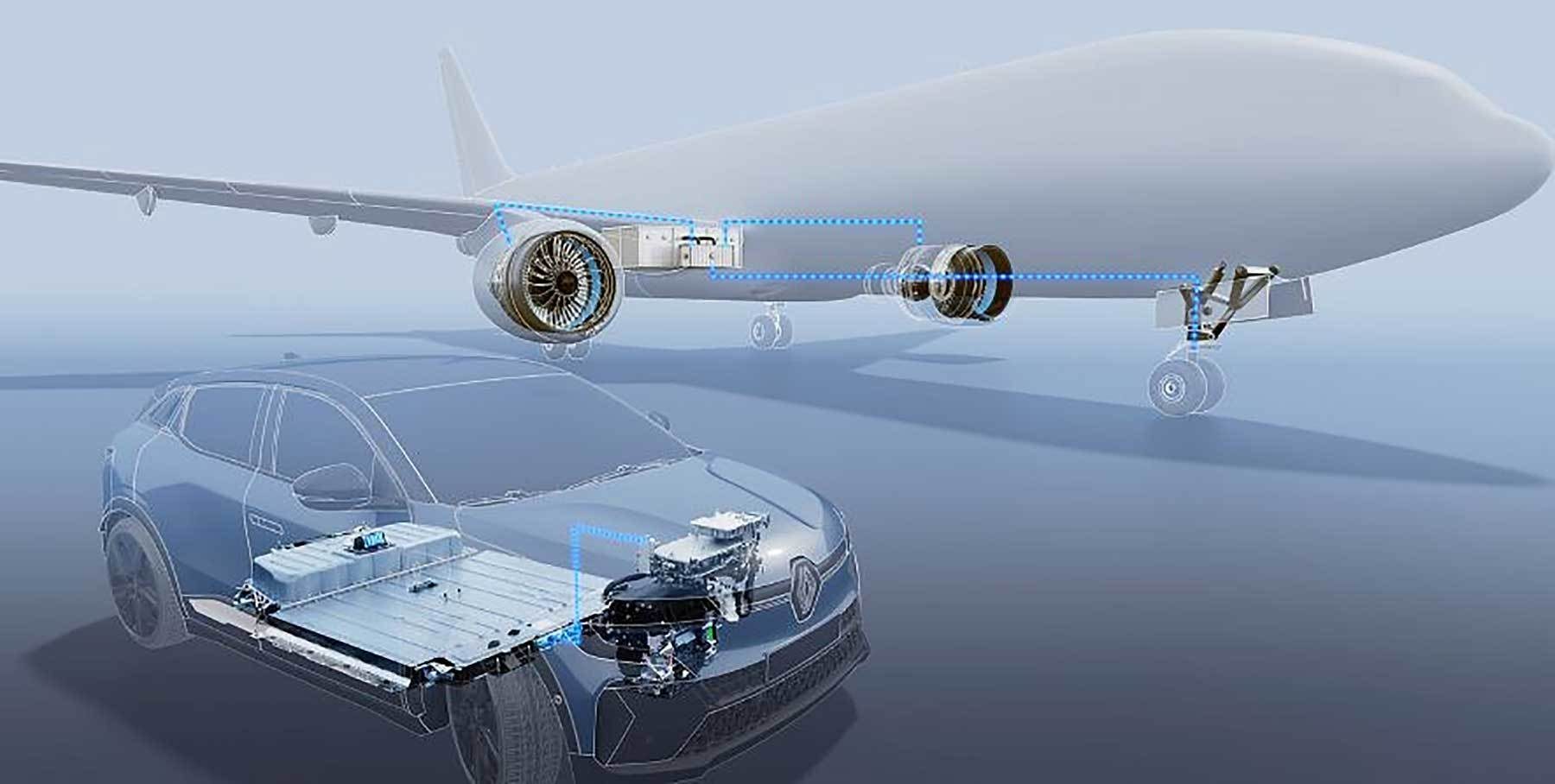
Airbus and Renault are developing new battery technology for use in aircraft and automobiles. Illustration courtesy Airbus
Building a Better Battery
Improving the overall performance of batteries will be key to the long-term development of more sustainable electric aircraft. Next-generation planes must be able to more effectively store the huge amount of energy required to take off while remaining lightweight.
One of the big drawbacks of today's lithium-ion batteries is that the slightest defect can generate a thermal management problem in the battery cell.
Engineers at NASA have been addressing the challenge. They recently developed a solid-state battery architecture capacity of 500 watt-hours per kilogram—double that of an electric car—that can eliminate 30 percent to 40 percent of the battery’s weight.
"That's incredible, and these advances are coming even faster than we thought they might be," says Eviation’s Davis. "We have the design, architecture and battery system already done. [The goal] is to pick the best battery technology available at the time."
"In a car, it's not a problem, because you're on the ground,” adds Faradair’s Cloughley. “When you're driving along, if you smell smoke or if it gets warm, you can pull over to the side of the road. But, if you're 10,000 feet up in the air at the time, you're in trouble."
Issues can arise when a battery must be charged quickly and often, which Cloughley says can agitate the battery and result in a significant potential for failure. "If you trickle charge overnight, there's no problem because there's a nice, gentle, steady charge rate," he explains.
However, that doesn't work for an aviation asset where operators want to be turning a commuter aircraft around in 20 or 30 minutes.
"If you fast charge the battery, you run the risk of agitating it and creating a thermal management problem,” warns Cloughley. “You also decrease the battery's capacity capability. Every time you fast-charge it, you kill it by a fraction."
Battery energy density is another area of improvement. Fortunately, there’s a lot of research driving advances for batteries.
"Naturally, when you have a small pack providing a lot of energy, it would be better," say Heart’s Fragnan. "I know that this is the drive for the battery suppliers. They are working on this very, very seriously and we are counting on this as well."

Electric aircraft motors are much quieter that traditional alternatives. Illustration courtesy magniX
Reducing Component Weight
Another big technical hurdle involved in developing electric propulsion systems for planes is minimizing the weight of components such as motors and controllers.
"The next great hurdles involve moving beyond the parts and looking at how these parts integrate with each other and, critically, other aircraft systems, such as the propeller and propeller governor," says David Sercombe, vice president of the magni350/650 program at magniX.
The start-up company has developed electric propulsion units (EPUs) and energy storage systems for aircraft. It prides itself on how much thought is given to the way magniX’s system is designed to integrate with aircraft, from the engine mount, to the way the propeller loads are reacted through the motor. In addition, the EPUs are electron agnostic, meaning they can be powered by any electric power source.
"After the piston engine and jet engine, the electric motor promises to usher in a new age of flight," claims Sercombe. “One unique attribute of the assembly process of an electric propulsion system is translating the unique demands of the aerospace industry where quality, traceability and documentation are paramount.
"The challenges lie in creating solutions that are not only exceptionally powerful or torque-dense, but that are also built in a traceable, repeatable manner within an aerospace quality framework," explains Sercombe.
Eviation’s Davis points out that while traditional aircraft get lighter as the weight of fuel burns off, an electric-powered aircraft's weight remains the same from takeoff to landing. "The main thing for designing an electric airplane is that you optimize your lift over drag ratio,” he says. “You make sure the aircraft is as sleek as it can be, and all your other components are as light as they can be so you can maximize the available weight for your battery. Many new aircraft are also made with carbon-fiber composites to optimize weight savings.”
Electric aircraft engineers must take the best from what electric vehicle technology has to offer to maximize energy density.
"In the case of a car, the battery weight is already bad, but in a plane, it is far worse, which means the lightweight factor must be of major importance," says Gartner’s Pacheco. "Instead of using a metallic casing for the battery, for example, [engineers are] looking at [what] they can do to lighten up the battery and take the same approach for the electric motor."
With electric motors, however, the problem is not the amount of power it can generate in comparison to an internal combustion engine.
"You can achieve the same power you have today for an internal combustion engine with a much smaller electric motor, and this will be an advantage in terms of weight from the perspective of the motor," notes Pacheco. "The issue is the battery, because it weighs a lot more than the fuel you would typically have on a conventional propeller plane."
This means aircraft manufacturers must focus on is optimizing the overall aspects of plane efficiency—exactly what automakers have done.
"Now, you don't need space to store fuel,” says Pacheco. “In this space, you can now store batteries. "But, the form factor may be very different, and they must cater to that particular aspect and invest in more lightweight materials.”
Despite all the gains that could be made from more extensive use of lightweight materials and carbon fiber, at the end of the day, the weight of the batteries is a central issue.
"Batteries would still be the Achilles heel when it comes to reducing weight on the entire plane," Pacheco point out. "The aviation sector needs better battery technology."
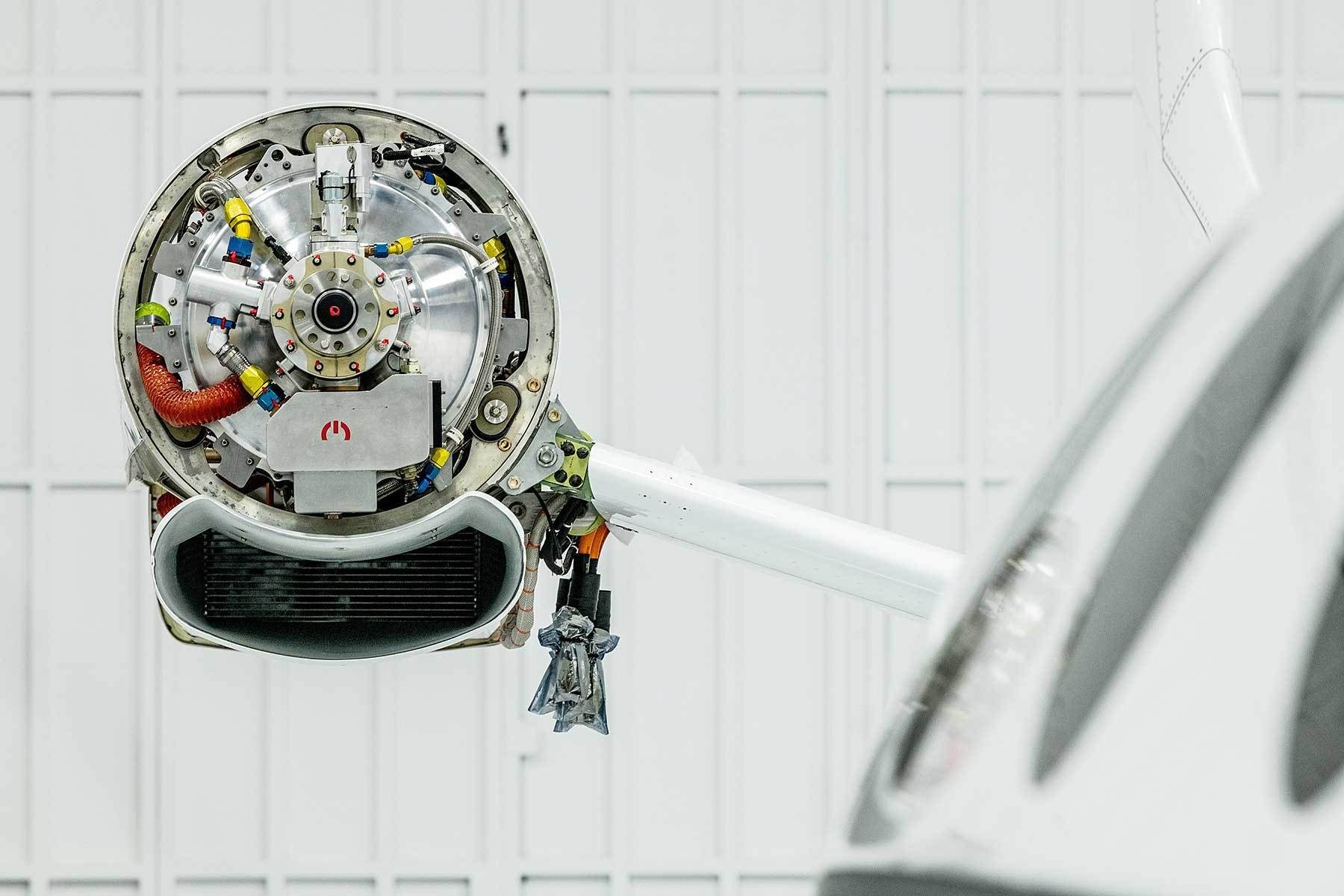
In the future, more aircraft will be equipped with electric propulsion systems. Photo courtesy magniX
Preparing for the Long Haul
There’s still a long way to go before additional issues surrounding batteries, such as storage capacity, charging infrastructure and uniform standards, are resolved.
"None of that's been decided, so putting a commercial aircraft into service any time in the next few year is just not feasible," says Faradair’s Cloughley. "Of course, we want batteries to improve and hydrogen fuel cells to become an option. This is just the starting point."
The company’s BEHA aircraft has been designed so that as other technologies enter the picture in the near future, its APU can be swapped out and replaced with another type of power source.
There will be a significant period of development before the widespread use of battery-powered airplanes becomes a reality. And, it is far from certain which technology the broader industry may eventually settle on—be it fully electric, hydrogen fuel cells or a hybrid system.
"We know the aviation industry is branching into different directions, because there is uncertainty in terms of how soon batteries will be good enough to enable a mid-sized commercial aircraft to fly 100 percent electric," says Pacheco. "That's the key thing."
The aviation industry at large is still not facing the type of regulatory push that has spurred automakers to develop electric drivetrains—including substantial monetary investments.
"This is where scaling and resources come into the picture,” explains Pacheco. “The aviation sector understands the need to get greener, but regulation-wise, the industry is not yet there. "They're not at the turning point like the automotive industry faces in China and Europe, where you need to sell a certain number of EVs annually to avoid getting a heavy fine."
"There's an awful lot of 'hopium' being peddled by a lot of people with good intentions, but we've also got to be realistic, and we must manage investor expectations," warns Cloughley. "If we do things incrementally, little steps up the ladder, we'll get there.
"If we can do this sensibly and if we can be realistic about our expectations, the future is hugely exciting for what we can achieve," says Cloughley. "We've just got to get there."
Major milestones like Eviation's Alice test flight make the future of electric flight more tangible.
"It's happening," claims Honeywell’s Alberstadt. "There aren't major technological hurdles anymore. Is battery technology exactly where we want it to unlock everything we want to do in the future? No. But, is battery technology sufficient today to enable a lot of the missions that can still revolutionize the way we travel? The answer is yes.
"This is no longer a pipe dream or a Jetson’s TV episode from 50 years ago that's never going to happen," says Alberstadt. "Electric aircraft are flying now."
With support from NASA, engineers at several U.S. universities are developing advanced fuel cells and electricity-conducting technology to generate power for fully electric aircraft of the future. Hydrogen fuel cells have yet to achieve use in powering large aircraft due to engineering challenges associated with weight, temperature and electric loads.
The Center for High-Efficiency Electrical Technologies for Aircraft (CHEETA) is developing new technology to incorporate fuel cells into commercial aviation. CHEETA is a consortium of nine universities and two industry partners that is led by the University of Illinois.
“We’re investigating different characteristics of how fuel cells operate as powerplants for future electric aircraft,” says Phillip Ansell, Ph.D., an associate professor of aerospace engineering who serves as CHEETA’s director. “Hydrogen is a great energy carrier, because there isn’t any carbon involved.”
However, there are challenges involved in applying fuel cell technology to aviation. For instance, to remain an effective power source, hydrogen must be cooled down to its liquid state (-423 F). Storing this cryogenic liquid requires tanks that are heavier than those used to hold regular jet fuel, which has made it difficult for fuel cells from achieving widespread use in aviation.
Another challenge is fuel cells must be able to generate enough electricity to power a large airplane, and then efficiently conduct, the electricity to the aircraft’s propulsion and power systems. In the past, powering an airliner the size of a Boeing 737, which must generate more than 20 megawatts of power to operate, was considered too challenging. However, Ansell and his colleagues believe recent technological advancements have changed that.
“We looked at the numbers and realized the state of the art is not far from an approach that works,” says Ansell. “There is a lot of potential.”
CHEETA is designing a unique prototype airliner built around the use of fuel cells and the challenges associated with their use.
“Since fuel cells are inherently different as a power source, the standard rules of aircraft design change drastically,” explains Ansell. “We are looking to write the book on how you make this system work for an airplane.”
CHEETA recently partnered with GE Research to design a new type of lightweight hydrogen tank for use on an airliner.
“We came up with a tank designed to have the long life needed for airplanes that can also identify leaks and other issues,” says Ansell. “It could be turned into a practical product that enables hydrogen use in the future.”
In addition, CHEETA has worked on designs for new technology to handle massive electrical loads, as well as manage the issues of heat and thermal management.
“In collaboration with Boeing, we did some tests to see how fuel cells adjust when changing the power demand on them,” Ansell points out. “We also did tests to see how changes in the way incoming air to the fuel cell is pressurized to improve net power production at high altitudes.”
Fuel Cells Promise Big Potential for Future Propulsion
This prototype electric airliner will use a fuel cell propulsion system. Illustration courtesy NASA/Center for High-Efficiency Electrical Technologies for Aircraft
A Sustainable Future
Electric aircraft will eventually enable point-to-point air travel, with lower operating costs and the ability to introduce new modes of transportation without harming the environment.
"We're going to have new markets giving people access to these aircraft, which will benefit rural communities," predicts Eviation’s Davis. "It's going to help airports that would otherwise be shut down because of noise restrictions."
An electric plane would have an advantage in terms of energy efficiency, because an electric power train limits thermal losses, which means more efficiency. With significantly reduced operating costs, electric aircraft have the power to change the economics of travel, as well as eliminate carbon emissions.
"We believe that electric aircraft will change the world of aviation and modernize an outdated, environmentally taxing system," says magniX's Sercombe. "Traditional fuel-powered aviation is a significant contributor to climate change."
Replacing environmentally harmful planes with electric alternatives will be vital to environmental protection and ensuring a more sustainable future for all. As the market develops, costs will come down and electric aircraft services will grow dramatically.
MAY 2023 | ASSEMBLYMAG.com


